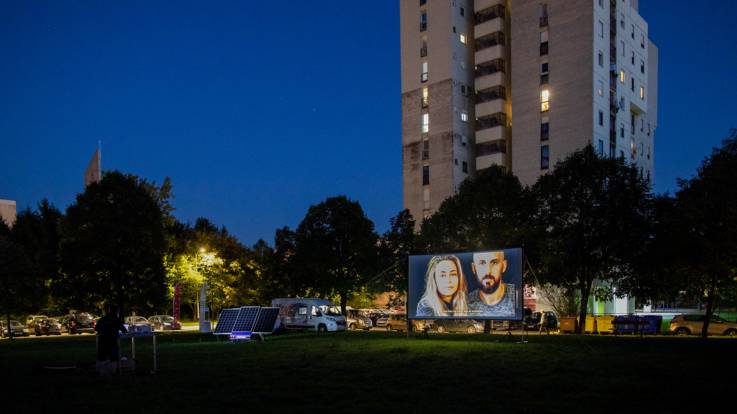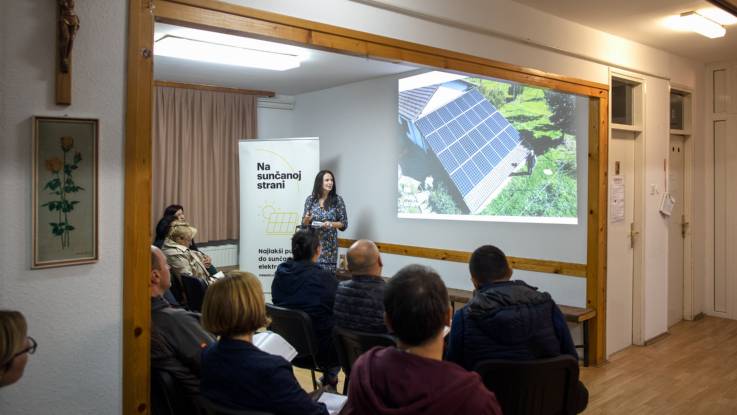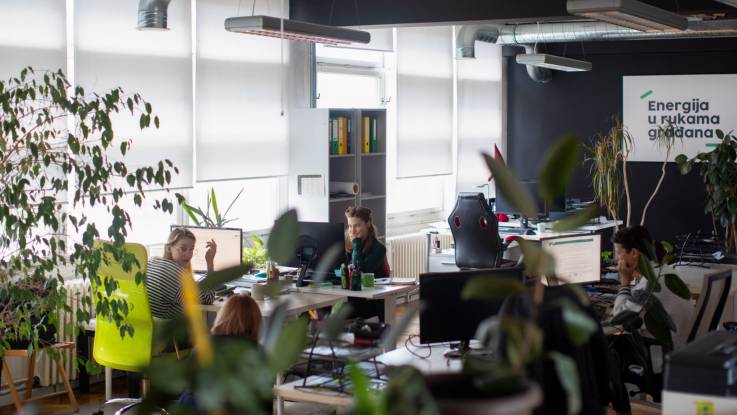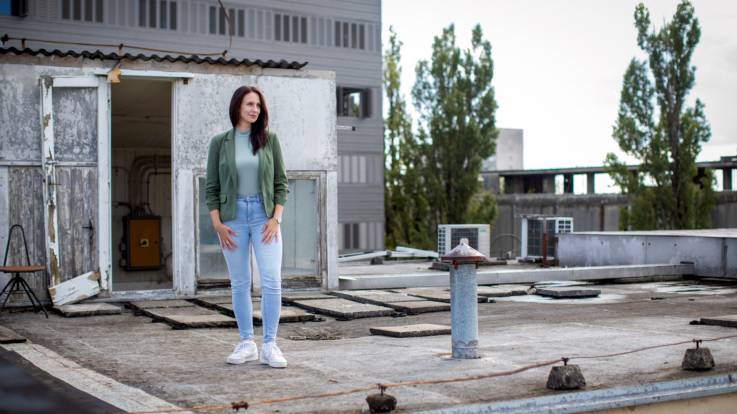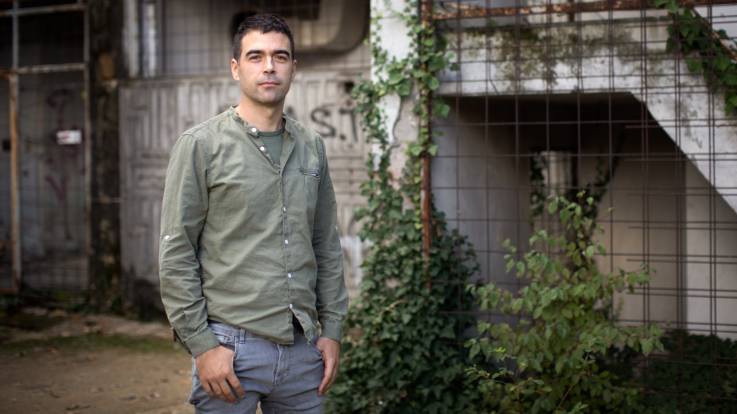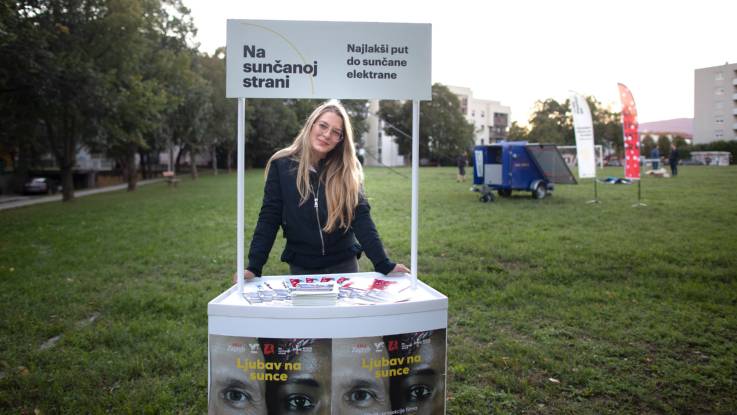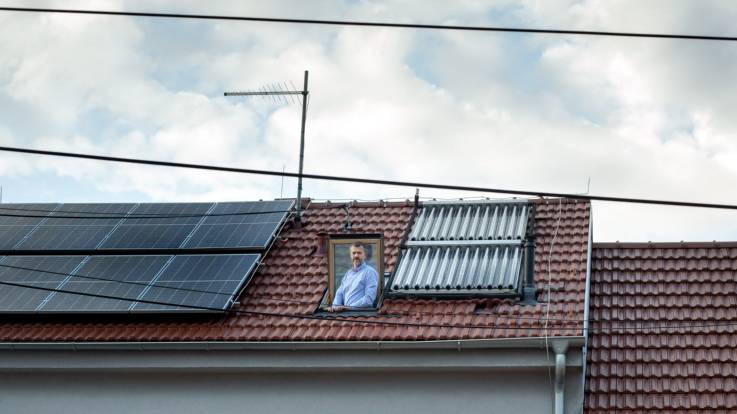Croatia goes over to the sunny side
A report by Adrian Meyer
Despite its enormous potential, solar energy has yet to get off the ground in Croatia. A green energy cooperative called ZEZ wants to change that.
A solar-powered open-air cinema would be unusual in most locations, but in the middle of a field in Dubrava – a neighbourhood in East Zagreb – it feels particularly out of place. It is a clear September night, and on a plot of land where kids usually play football, a film is being projected onto a big screen. The backdrop is made up of communist-era prefabricated buildings up to 15 storeys high, which tower over long streets of well-kept terraced houses. Here and there, the concrete walls are covered in graffiti tags for the “Bad Blue Boys” – the hard-core fans of local football team Dinamo Zagreb. The club’s stadium is not far from this residential area, where few tourists ever venture.
It’s not a warm evening – too cool, really, for an open-air film and picnic. Nevertheless, some two dozen viewers are huddled on the ground, blankets wrapped around their shoulders for warmth and a beer or a snack in their hands. They have come to watch the Croatian-German documentary Love around the World, which explores love in different cultures, regions and religions. The 2021 film is very popular in the Balkans. Before it begins, the gaze of the audience takes in a blue car trailer sitting in the middle of the makeshift cinema with the words “Dobra Energija” (“good energy”) written on its side. This trailer is actually the beating heart of the cinema: it houses a mini solar plant that powers both the projector and the sound system. Three photovoltaic (PV) modules are installed on top, and it contains a battery to store the energy they generate.
In truth, this evening’s film is something of a decoy: “We want to demonstrate in a simple way that solar energy works,” says Zoran Kordić of the Green Energy Cooperative, or Zelena Energetska Zadruga (ZEZ) in Croatian. ZEZ is currently touring the neighbourhoods of Zagreb with its solar cinema to demonstrate the benefits of solar energy. “We want to use this film about love to also ignite a love for solar energy,” adds Kordić’s colleague, Melani Furlan. Thirty-six-year-old Kordić is co-founder of ZEZ and, along with 31-year-old Furlan, one of its main driving forces.
Informing, inspiring and motivating
If any of the moviegoers want to learn more about the project, explains Kordić, they are invited to attend one of ZEZ’s weekly information evenings that are held throughout the country to educate people about the benefits of solar energy. “Maybe, with our support, they will soon have a photovoltaic system installed on their own roof – and inspire their neighbours to do the same,” Kordić adds. He and Furlan have a vision of entire neighbourhoods pooling their resources and jointly purchasing solar panels, which could then lead to the formation of local, citizen-led energy communities.
The cooperative’s goal is to establish a decentralised, affordable and renewable energy system that is co-owned by citizens. The members have been working towards this goal for years now, during which time they have already experienced a number of setbacks. Their dream was almost crushed entirely by Croatian politicians, who have been unwilling to advance solar energy and unable to do anything about the monopoly held by national power company Hrvatska elektroprivreda (HEP).
So much potential – so little power
In fact, Croatia is one of the EU’s worst performers in terms of solar expansion. In 2021, solar power accounted for less than one percent of the country’s energy mix. And yet in general, renewable energy consumption is relatively high in Croatia: around 70 percent of its electricity is generated by hydroelectric, wind and biomass plants. Hydropower in particular has long kept electricity costs in the country low, with one kilowatt hour currently costing 1.06 Croatian kuna – the equivalent of about € 0.14. But the country is still heavily dependent on oil, coal and gas imports. In dry years, when the hydropower plants cannot supply enough energy, fossil fuels from abroad fill the gap – and climate change is making low-rainfall summers all the more frequent.
To expand the country’s renewables sector, Croatian politicians have so far mainly turned to wind power. Hundreds of turbines have been erected in the country in recent years, often by international corporations. Yet solar energy remained unsubsidised for a long time and was therefore simply not competitive. As a result, Croatia’s photovoltaic capacity is still rather meagre: early this year it was a mere 140 megawatts – with a potential of 6.8 gigawatts.
And so it is that, in a country that enjoys more than 2,300 hours of sunshine each year, solar energy has barely got off the ground. But this seems set to change: as a result of the COVID-19 pandemic, the Russian war of aggression against Ukraine, and rising energy prices, Croatia is currently experiencing its first-ever solar boom.
While the reasons behind this development are hardly joyful, the resulting situation is, in Zoran Kordić’s words, “an opportunity we have long been waiting for.” Kordić and Furlan lead us through the loft-like ZEZ office and tell us about their plans. The office is located on the top floor of a brutalist post-war building on the outskirts of Zagreb. Yugoslavian electronics company Radio Industrija Zagreb (RIZ) once produced radio and TV sets in this space; now office dog Kimi pads leisurely over the parquet flooring. A total of 20 people, including eight students, work at ZEZ as part of a young and diverse team.
We have been infected with the ›solar virus‹.
While calm and quiet Kordić works in the background as a strategist, community expert Furlan is more actively involved in concrete projects. Both studied electrical engineering in Zagreb and stayed on in the capital to work for the United Nations Development Programme (UNDP), which is where they met. One of their first projects involved supplying Croatian farmers and their families in remote villages with stand-alone photovoltaic systems. These families had been cut off from the grid since the Yugoslav Wars. Now, thanks to the solar panels, they were able to produce their own electricity without expensive diesel generators. Saving money on diesel enabled them to buy refrigerators, meaning they could store the milk from their cows and sell it – previously they only produced milk for their own needs. This experience taught Furlan and Kordić that solar energy not only provides electricity, it can empower people to live more independent and self-determined lives. “We have been infected with the ‘solar virus’ ever since,” says Furlan.
From success to standstill
The Green Energy Cooperative (ZEZ) was established in 2013, initially as part of a UNDP project. Passionate about the idea of collective solar energy production, ZEZ saw itself from the outset as an umbrella organisation for the promotion of green energy cooperatives throughout the country.
The members began by organising a successful crowdfunding campaign in the town of Kaštela on the Dalmatian coast. With the help of local citizens, they raised enough money to install solar panels on the roof of a state school – a first for Croatia at that time. “This was proof that we could make something happen ourselves,” says Kordić. The next step was for ZEZ to find groups throughout the country keen to establish their own local energy cooperatives and to help them on their way with advice and logistics, as a kind of mentor. ZEZ experienced its first success on the island of Krk, where 300 citizens came together to form Croatia’s first local energy cooperative and install solar power plants. Their goal was to make the island climate-neutral by 2030. “That was when we really knew that our vision had the power to motivate others,” says Kordić.
The end of the feed-in tariff blocked us for years.
But just when ZEZ thought it was on the verge of a breakthrough, politics got in the way. In 2014, the Croatian government announced the end of the existing feed-in tariffs. “That blocked us for years,” recalls Kordić. “No one wanted to invest in solar power any more – it just didn’t make financial sense.”
Four difficult years passed before ZEZ experienced its next solar success. It was able to motivate citizens in the small town of Križevc northeast of Zagreb to pool their resources and install a photovoltaic system on the roof of the local government building. In just ten days, 53 donors were found who were willing to invest the equivalent of € 500 each in a 30-kilowatt system that is operated in partnership with the municipal government. Two years later, the initiative developed into the local citizens’ energy cooperative KLIK – again with the support of ZEZ. KLIK wants to take the energy transition into its own hands and use solar projects to make the town more energy-independent. Today, Križevci is considered one of Croatia’s leading municipalities on the path to climate neutrality.
Battling an anti-cooperative culture
But to get to this point, ZEZ had to convince a lot of people – both politicians and ordinary citizens. Melani Furlan recalls how much time and energy this work required: “There was very little interest, and our campaigns made only very slow progress. The people and politicians just didn’t understand what cooperatives can achieve.” The problem, she says, was not only the high investment costs but also a culture of self-interest that prevails in Croatia today and makes life difficult for cooperatives. Following the violent breakup of Yugoslavia, the sense of community suffered: “The war created lasting mistrust and has led to people only looking out for themselves,” Furlan explains. “The idea of contributing to the common good has neither political nor cultural support.” Also, the Croatian word for cooperative (“zadruga”) evokes unpleasant memories of the communist era, when agriculture was forcibly collectivised and – following the land reform – dominated by state-run cooperatives.
It’s time for a cigarette break. Furlan and Kordić climb onto the roof of the office and get out papers and tobacco. From up here, we look down on a derelict building with a modern office complex right next door. Behind that are the treetops of the huge Maksimir Park – Zagreb’s green lung – and the sloping roofs of suburban terraced houses. The massive potential for solar installations is immediately clear. “There could be solar panels on all these roofs,” says Kordić, making a sweeping gesture. He sounds both wistful and hopeful.
We took anything we could get.
Speaking to Kordić, one senses that he would like to be a lot further along with ZEZ’s vision and is worried the past years may have been wasted time. Because of the brakes that were put on the solar sector’s development, ZEZ had to temporarily focus its attention simply on surviving financially as an organisation. It achieved that by participating in EU research and innovation funding programmes – eight in total. “We took anything we could get,” says Kordić. Through those programmes, ZEZ helped a total of 20 towns make progress in the areas of energy efficiency and renewables. Kordić recognises that they built up a lot of trust with that work – and that this trust could now start bearing fruit. But even while their efforts were tied up in the EU projects, Furlan and Kordić never lost sight of their citizens’ energy vision, and continued to work out a plan as to how that dream could yet become a reality.
ZEZ is taking a more pragmatic approach: “We need to work on the general solar infrastructure before focusing too much on founding cooperatives,” explains Kordić. The main thing, he says, is to get the solar sector moving again after all the years of stagnation – and the easiest way to do that today is through private photovoltaic systems on homeowners’ roofs. As an added bonus, the Croatian government even introduced state subsidies in 2019 to encourage homeowners to generate their own solar power. “That’s the new focal point of our campaigns.”
Current legislation has left ZEZ little choice but to put the idea of community energy on the backburner for now. The cooperative would also like to help tenants get involved in the energy transition. The closest thing to the ideal picture of citizen-owned energy, they say, is neighbours joining forces to install and operate a photovoltaic system together. But sadly, such systems are still not permitted on the roofs of rental buildings.
An online platform for information and networking
So ZEZ decided to specifically target those homeowners for whom a solar installation is already an option. Two years ago, the cooperative launched the online platform “Na sunčanoj strani” (“On the sunny side”), which provides free advice to homeowners looking to install their own photovoltaic system. ZEZ checks whether it is worthwhile at the specific location, how much investment it would require, and what the savings would be. ZEZ also informs users about which permits they need and how to find an installer. The cooperative works with around 30 certified solar technology companies that can be contacted via a directory on the website.
Furlan, Kordić and their fellow campaigners also organise information events throughout the country on an almost weekly basis to present their online platform and answer any questions about private photovoltaic systems. When Melani Furlan asks the audience when they want to install their own solar panels, most of them answer: “As soon as possible!” But many simply don’t know how to go about it.
This is precisely the information gap that ZEZ wants to fill. With its “sunny side” campaign, the cooperative has already provided free advice to some 2,000 people. “For us, this is a huge success,” says Furlan. The team is also trying to consolidate the contacts it has made through this work with a view to building a robust solar community. On Facebook, for example, ZEZ has set up the “Solar Club”, which now has 30,000 members who actively exchange information about solar energy and motivate each other to become solar power producers. The cooperative hopes this community maybe even has the potential to grow into a nationwide citizens’ movement.
Neighbourhood pioneers
One of the homeowners who caught the solar virus thanks to ZEZ is Tomislav Lokmer, a 46-year-old IT engineer who lives in a quiet neighbourhood of terraced houses in East Zagreb. Ten years ago, he built his own home 200 metres from his parents’ place. It has a modern interior, with much of the furniture handmade by Lokmer himself in his garage. The exterior of the house immediately stands out due to the solar heating system and eight PV modules installed on its roof. Two other roofs in the immediate vicinity are also decked out with PV systems – but they are the only ones in the entire neighbourhood. “We are pioneers!” Lokmer laughs. That’s no overstatement given there are only 3,000 solar installations in the entire country.
Having support from the cooperative ZEZ was a great help!
Lokmer came across ZEZ on the internet a year ago. He initially made contact merely to enquire about a measuring device the cooperative was selling, but he got into conversation with one of the members, who suggested that he invest in his own photovoltaic system. Back then, homeowners could apply for state subsidies for private solar plants – and Lokmer decided to try his luck. He explains how ZEZ supported him throughout the process: “It was a great help!” He began producing his own electricity this summer – officially making Lokmer an electricity “prosumer”. And as the August sun provided far more energy than he himself required, Lokmer now also benefits from the new renewable energy law: Croatia’s national energy company HEP pays 80 percent of its usual tariff for the surplus electricity he generates. The credits are automatically deducted from his electricity bill.
Ultimately, Lokmer opted for a PV system to save money. It cost around € 6,000, and he received almost half of that from subsidies. “The system will have paid for itself in six years,” he says. “Probably even faster with the rising cost of electricity.” Financial benefits aside, he is also a proponent of the technology: “The fact that it also protects the environment and makes Croatia more independent is a big plus.”
Solar energy will grow exponentially in Croatia.
More and more Croatians are beginning to share Lokmer’s view. Something has changed in the past few months – the team at ZEZ can feel it. The number of enquiries has doubled this year, and three times as many people are coming to the information events. As rising energy prices put increasing strain on Croatian households – who are now paying up to 20 percent more for their electricity – solar power has suddenly become a worthwhile investment.
Since the beginning of the year, the number of private solar installations in Croatia has almost doubled, from 1,500 in February to almost 3,000 in the summer. Kordić is well aware that this number is still very low, but he is sure that this is just the beginning: “Solar energy will now grow exponentially in Croatia.” He envisages that by 2030 100,000 households in Croatia will be producing their own solar power – that’s one in five households. “It’s a realistic goal!” Kordić insists.
With the long solar standstill and a great many obstacles now behind Kordić and Furlan, this seems like a promising time to implement new plans. Soon, they aim to establish a new cooperative called “Sunce” (“Sun”) that will focus even more on solar expansion. The goal is to create a social platform that brings together towns and municipalities with investors and new members for energy cooperatives. This way, they hope to revive the original idea behind ZEZ: for citizens to collectively take the solar energy transition into their own hands, giving them greater energy independence and a share of the profits. Kordić is certain of one thing: Croatia is finally going over to the sunny side.
Lead photo: Toby Binder / Translated from the German by Grace Winter / Babelfisch Translations. You can also read the report in German.
+ Update (2024) + Since the summer of 2022, ZEZ has ramped up its commitment to citizen-led solar expansion with educational activities and online services. By offering joint financing to local groups, it has facilitated the installation of 60 additional PV systems with a capacity of 430 kilowatts. A total of one megawatt of additional solar energy has been achieved so far thanks to ZEZ.
Related stories
-
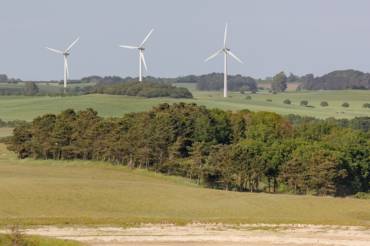
Winds of Change on Samsø Island
The Danish island of Samsø produces more energy than it consumes. A dynamic couple and a dedicated community are the secret of its success.
-
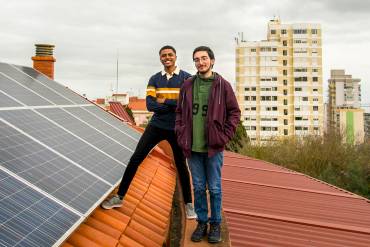
Solidarity through sunlight
Cooperative solar panels on the roofs of social facilities in Portugal show how citizens’ energy initiatives promote solidarity and community spirit.
